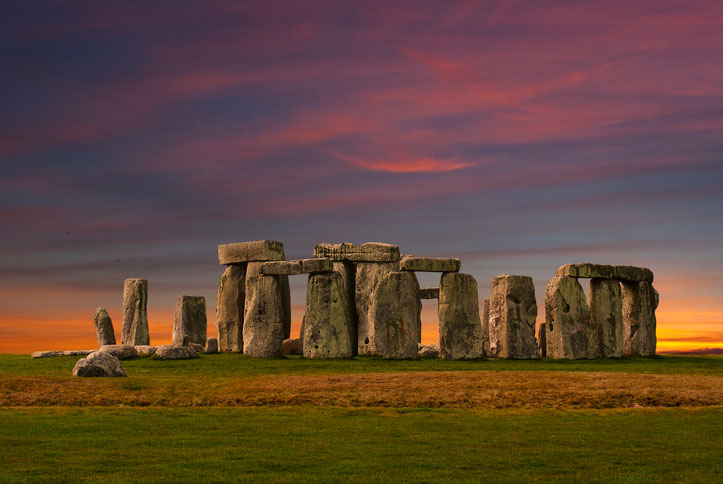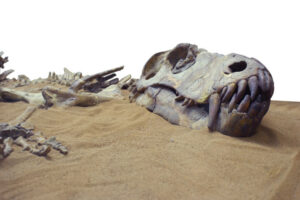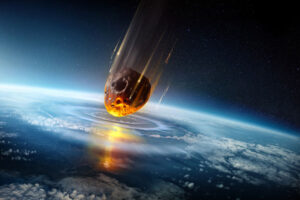

We wouldn’t be where we are today without geology. It may not be immediately obvious, but geology has actually contributed to the technological advancement of civilization every step of the way. It fits hand-in-hand within a liberal arts context as cultures, history, and religion have co-evolved with advances made in geological science:
- Mining and smelting literally brought humanity out of the stone age and into the ages of metals: the Chalcolithic (copper) Age, the Bronze Age, and the Iron Age.
- For millennia up to the present gold has been used as a common currency enabling cultures to interact with each other, driving exploration and trade throughout the world.
- Coal seams made the industrial revolution possible, bringing the world into the era of machines.
- Copper enabled the world to have an electrical grid.
- Oil and natural gas powered the developments of the 20th and 21st centuries.
- Uranium brought us into the nuclear age with weapons, medicine, and power.
- Rare earth elements have enabled advancements in computers, electronics, batteries, and solar power, laying the foundation for a future that’s based on renewable energy.
Not only has geology had an important impact on the progress of society, it has fundamentally reshaped our understanding of who we are and where we come from; two issues the liberal arts frequently address through art, religion, and philosophy.
What is Geology? Answering the Big Questions in a Liberal Arts Context
Geology is at the root of all earth sciences as being the fundamental study of rocks – how they’re formed, how they age, and how some are reabsorbed in subduction zones. Our understanding of the earth and our relationship with it has been shaped over millennia by geology.
Although in some sense humans have always valued geology, it didn’t become a branch of science in its own right until relatively recently starting in the 18th century. Since then, it’s revolutionized our understanding of our world and the universe. Today, exogeologists are vital team members at NASA who design some of the most important components of the rovers we send to other planets.
Geology is an integral part of the liberal arts. It’s a branch of science that helps cultures to thrive and develop. It answers important questions that were traditionally the purview of religion and philosophy. That’s why learning geology within a liberal arts context is such a natural fit.
Understanding Fossils Revolutionizes Our Concept of Our Place in Time
 Humankind has encountered fossils throughout our entire existence. However up until the relatively recent past they were considered to be novelties, perhaps used as adornments on tool handles or statues.
Humankind has encountered fossils throughout our entire existence. However up until the relatively recent past they were considered to be novelties, perhaps used as adornments on tool handles or statues.
Still, some fossils did inspire the imagination. Gigantic, fossilized skulls and bones were often explained by cultures throughout the world as details in their creation myths and folklore. Other fossils were strange not for their size but for their location: why were fossils of sea creatures that lived in warm deltas being found in cold mountainous regions?
The study of fossils didn’t start to resemble what we now know today until the 18th century thanks to advancements in understanding that were taking place in Europe. In the 1600s everyone still thought the earth was only a few thousand years old.
However, the scientists of the day began to make progress. First, they realized that fossils must be the remains of creatures that were once alive. Fossils of elephants looked very similar to the skeletons of modern elephants. And it logically followed that some creatures must have gone extinct when fossils were discovered that did not resemble anything known.
Late-18th century developments in stratigraphy became possible with these new understandings of fossils. It became accepted that the layers of rocks exposed on a riverbank represented successive centuries of depositions that grew on top of each other over time. This realization was a major turning point. Looking at deep canyons exposing layers upon layers of sedimentary rock, early geologists realized that the earth must be millions of years old, rather than a few thousand.
By the 1900s some basic principles of geology had been established:
- Rocks are formed over long periods of time, with the oldest towards the bottom and the youngest at the top.
- Fossils represent species that lived millions of years ago, and species alive today are their descendants.
- Geological history is punctuated with periods of extinction.
The mystery of why fossilized sea creatures on top of mountains still remained, and this was soon explained by the theory of plate tectonics. This surmised continental drift and described how mountains were formed.
Finally with the advent of the nuclear age geologists made another important breakthrough with radiometric dating.
Some carbon in the atmosphere gets hit by solar rays and becomes radioactive. This carbon dioxide is circulating in the air and becomes part of plants when they “breath” it in, and part of animals when they eat the plants. The radioactive properties of this type of carbon mean that every 5,730 years its total present amount decreases by half; its half-life is 5,730 years. This is the basis of radiocarbon dating, and the same principle can be used with other radioactive elements.
Radiometric dating provided rock-solid proof of how old the earth really was and made it possible to date fossils with pinpoint accuracy in terms of geological time.
Over just a few hundred years humanity realized our home was far older than what we’d previously thought. And in short time this knowledge extended to our place in the solar system when geologists dated meteorites and rocks brought back from the moon, and we realized that our earth formed along with the rest of the planets around 4.5 billion years ago.
In just a short time span geology has revolutionized our understanding of our place on earth and in the wider solar system, having profound implications on important philosophical questions about ourselves that the liberal arts has traditionally answered through the arts and religions that make cultures unique. This is why studying geology in the context of the liberal arts can be so enriching.
Asteroid Collisions Were Only Recently Accepted as the Cause of Major Mass Extinction Events on Earth
 While it was obvious dinosaurs were extinct, blaming an asteroid impact wasn’t widely accepted until the 1990s. By observing rock strata geologists knew the dinosaurs suddenly went extinct 66 million years ago, but they didn’t know why. They came up with a variety of theories like:
While it was obvious dinosaurs were extinct, blaming an asteroid impact wasn’t widely accepted until the 1990s. By observing rock strata geologists knew the dinosaurs suddenly went extinct 66 million years ago, but they didn’t know why. They came up with a variety of theories like:
- Climate change – Unusually high levels of volcanic activity in present-day India released gasses that blocked sunlight and caused plants to die.
- Falling sea levels – Sea levels had been declining relatively rapidly 66 million years ago, and because plant and animal life is particularly rich in coastal areas it was thought that the rapid regression of coastlines could have caused a mass extinction event.
- Combination theories – Meteorite impacts weren’t ruled out as the cause for the dinosaurs’ extinction, but there wasn’t strong evidence for these either. Some geologists proposed that a combination of smaller meteorite impacts, plus climate change, plus falling sea levels had a cumulative effect that caused the extinction.
But over time geologists found clues to support the theory of an asteroid impact being the cause of the extinction, which was first proposed by a father-son pair of geologists in 1980. They took a close look at the rock strata layer that marked the end of the dinosaurs; a layer that could be identified at locations throughout the world. And everywhere they looked they found a thin layer of highly-concentrated iridium, which is commonly found in asteroids.
This was a good piece of evidence, but it wasn’t definitive. Critics pointed out that iridium could also have been released in very high concentrations by volcanoes. And if there had been a massive asteroid impact, where was the crater?
Those were fair points and hard to definitively refute, until the impact crater was located, now hidden under the Gulf of Mexico just offshore of the Yucatan Peninsula. This happened when geologists working for an oil company were surveying the gulf floor and found an anomaly that looked like a bullseye on their data map. They suspected it was a large impact crater, and this was confirmed in the 1990s when rock core samples revealed the presence of shocked quartz, which could only be explained by a huge asteroid impact.






